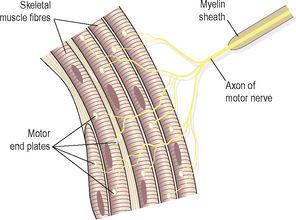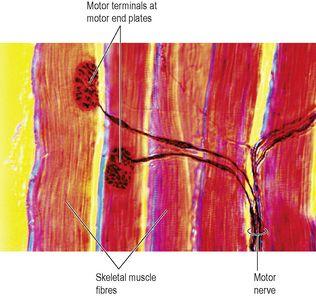Ross & Wilson Anatomy and Physiology in Health and Illness (191 page)
Read Ross & Wilson Anatomy and Physiology in Health and Illness Online
Authors: Anne Waugh,Allison Grant
Tags: #Medical, #Nursing, #General, #Anatomy

The axons of motor neurones, carrying impulses to skeletal muscle to produce contraction, divide into a number of fine filaments terminating in minute pads called synaptic knobs. The space between the synaptic knob and the muscle cell is called the synaptic cleft. Stimulation of the motor neurone releases the neurotransmitter acetylcholine (ACh), which diffuses across the synaptic cleft and binds to acetylcholine receptors on the postsynaptic membrane on the
motor end plate
(the area of the muscle membrane directly across the synaptic cleft,
Fig. 16.56
). Acetylcholine causes contraction of the muscle cell.
Figure 16.56
The neuromuscular junction.
Motor units
Each muscle fibre is stimulated by only one synaptic knob, but since each motor nerve has many synaptic knobs, it stimulates a number of muscle fibres.
Figure 16.57
shows an electron micrograph of a motor nerve and two of its motor end plates.
Figure 16.57
The neuromuscular junction: colour transmission electron micrograph of a motor neurone and two of its motor end plates.
One nerve fibre and the muscle fibres it supplies constitute a
motor unit
. Nerve impulses cause serial contraction of motor units in a muscle, and each unit contracts to its full capacity. The
strength
of the contraction depends on the
number
of motor units in action at a particular time.
Some motor units contain large numbers of muscle fibres, i.e. one nerve serves many muscle cells. This arrangement is associated with large-scale, powerful movements, such as in the legs or upper arms. Fine, delicate control of muscle movement is achieved when one motor unit contains very few muscle fibres, as in the muscles controlling eye movement.
Action of skeletal muscle
When individual muscle cells in a muscle shorten, they pull on the connective tissue framework running through the whole muscle, and the muscle develops a degree of tension (tone).
Muscle tone
When a muscle fibre contracts, it obeys the
all-or-none law
, i.e. the whole fibre either contracts completely or not at all. The degree of contraction achieved by a whole muscle depends therefore on the number of fibres within it that are contracting at any one time, as well as how often they are stimulated. Powerful contractions involve a larger proportion of available fibres than weaker ones; to lift a heavy weight, more muscle fibres are required to contract than to lift a lighter one.
Muscle tone
is a sustained, partial muscle contraction that allows posture to be maintained without fatiguing the muscles involved. For instance, keeping the head upright requires constant activity of the muscles of the neck and shoulders. Groups of muscle fibres within these muscles take it in turns to contract, so that at any one time, some fibres are contracted and others are resting. This allows the effort required to hold the head upright to be distributed throughout the muscles involved. Good muscle tone protects joints and gives a muscle firmness and shape, even when relaxed.
Muscle fatigue
To work at sustained levels, muscles need an adequate supply of oxygen and fuel molecules such as glucose. Fatigue occurs when a muscle works at a level that exceeds these supplies. The muscle response decreases with fatigue.
The chemical energy (ATP) that muscles require is usually derived from the breakdown of carbohydrate and fat; protein may be used if supplies of fat and carbohydrate are exhausted. An adequate oxygen supply is needed to release fully all the energy stored within these fuel molecules; without it, the body uses anaerobic metabolic pathways (
p. 308
) that are less efficient and lead to lactic acid production. Fatigue resulting from inadequate oxygen supply, as in strenuous exercise, occurs when lactic acid accumulates in working muscles. Fatigue may also occur because energy stores are exhausted, or due to physical injury to muscle, which may occur after prolonged episodes of strenuous activity, e.g. marathon running.
Muscle recovery
After exercise, muscle needs a period of time to recover, to replenish its ATP and glycogen stores and to repair any damaged fibres. For some time following exercise, depending on the degree of exertion, the
oxygen debt
remains (an extended period of increased oxygen demand), as the body converts excess lactic acid to pyruvic acid and replaces its energy stores.
Factors affecting skeletal muscle performance
Skeletal muscle performs better when it is regularly exercised. Training improves endurance and power. Anaerobic training, such as weightlifting, increases muscle bulk because it increases the size of individual fibres within the muscle (hypertrophy). Ageing reduces the size of muscle fibres as well as their endurance and strength.
The action of skeletal muscles
In order to move a body part, the muscle or its tendon must stretch across at least one joint. When it contracts, the muscle then pulls one bone towards another. For example, when the elbow is bent during flexion of the forearm, the main mover is the biceps brachii, which is anchored on the scapula at one end and on the radius at the other. When it contracts, its shortening pulls on the radius, moving the forearm up toward the upper arm and bending the elbow.
This example also illustrates another feature of muscle arrangement: that of
antagonistic pairs
. Many muscles/muscle groups of the body are arranged so that their actions oppose one another. Using the example of bending the elbow, when the main flexors on the front of the upper arm contract, the muscles at the back of the upper arm must simultaneously relax to prevent injury.
Isometric and isotonic contraction
Contraction of a muscle usually results in its shortening, as happens for instance to the biceps muscle if the forearm is used to pick up a cup. The power generated by the muscle is used to lift the manageable weight, and tension in the muscle remains constant. In this situation, the contraction is said to be isotonic (iso = same; tonic = tension). However, imagine trying to lift an 80 kg man with one hand. Most people would be unable to perform this task, but the muscles of the arm and shoulder would still be working hard as they attempted it. In this situation, because the resistance from the man’s weight is too great for him to be moved by the efforts of the lifter, the muscles would be unable to shorten, and the power generated increases the muscle tension instead. This is
isometric
contraction (iso = same; metric = length).
Muscle terminology
Muscles are named according to various characteristics (
Table 16.7
), and becoming familiar with the principal ones makes it much easier to identify unfamiliar muscles.
Table 16.7
Muscle terminology
| Characteristic | Example | Comment |
|---|---|---|
| Shape | Trapezius | Trapezium shaped |
| Fibre direction | Oblique muscles of abdomen | Fibres run obliquely |
| Muscle position | Tibialis | Found close to tibia in the leg |
| Movement produced | Extensor carpi ulnaris | Attached to the carpal bones of the wrist and the ulna, and extends the wrist |
| Number of points of attachment | Biceps brachii | Bi = 2; this muscle has two points of attachment at the shoulder |
| Bones to which muscle is attached | Carpi radialis muscles | Attached to the carpal bones of the wrist and the radius of the forearm |
The
origin
of a muscle is (usually) its proximal attachment; this is generally the bone that remains still when the muscle contracts, giving it an anchor to pull against. The
insertion
is (usually) the distal attachment site, generally on the bone that is moved when the muscle contracts.
Principal skeletal muscles
Learning outcomes
After studying this section you should be able to:
name the main muscles of the body regions described in this section
outline the functions of the main muscles described in this section.



